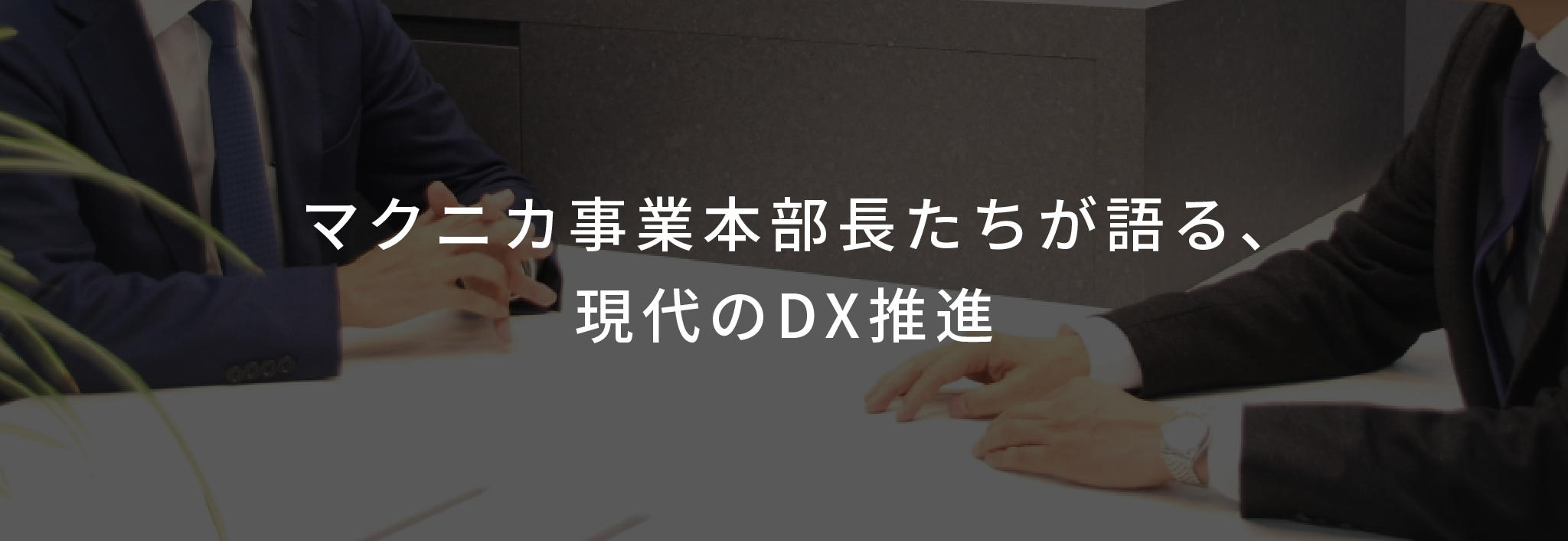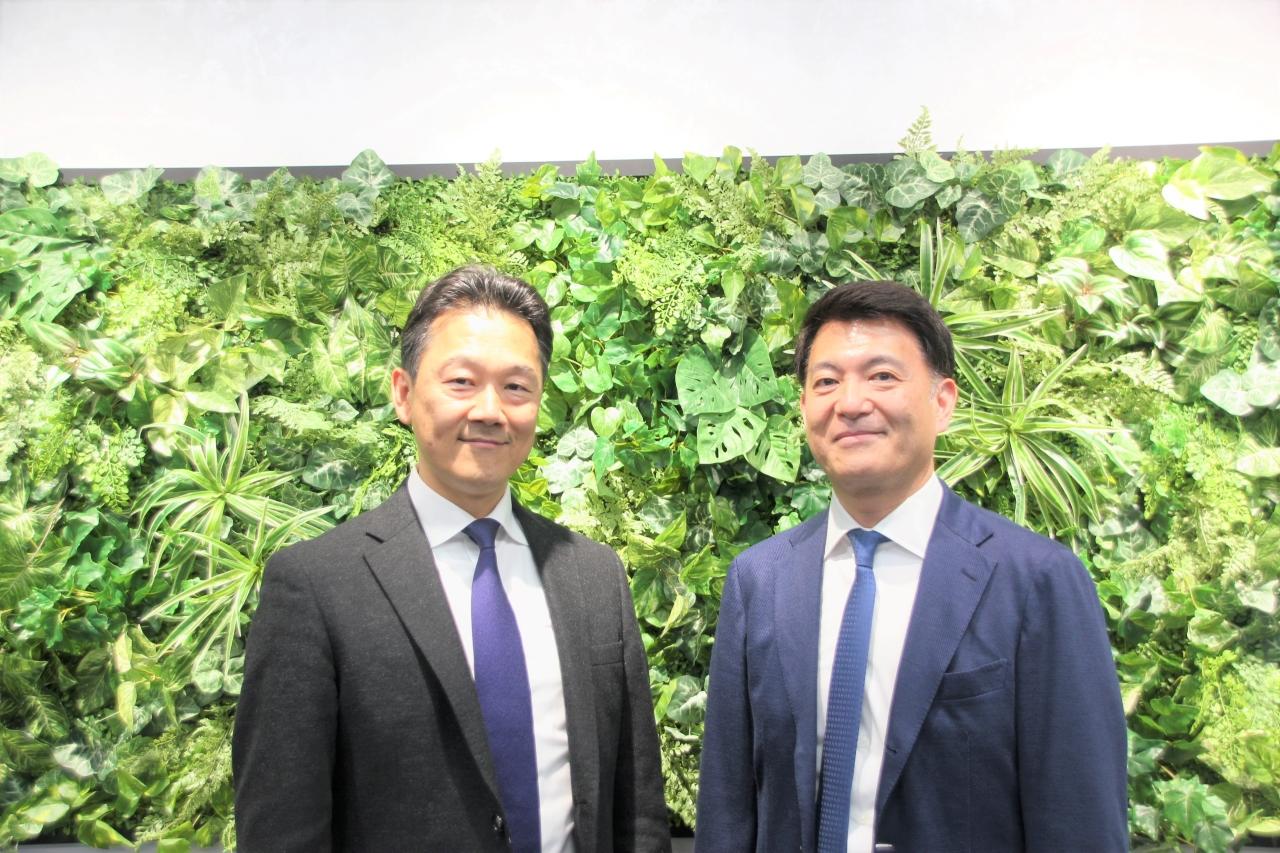
While promoting DX brings many benefits, such as improved competitiveness, operational efficiency, and customer satisfaction, the reality is that the hurdles to overcome are still high. In this environment, Macnica is not only supporting its customers, but is also focusing on in-house DX, including the concept of its unique organization, the "DX Factory."
In this article, we will provide hints on promoting DX and knowledge about Macnica through a discussion between the heads of the New Business Division and the IT Division.

▲Atsushi Sato, General Manager of the Innovation Strategy Business Division (left), and Keigo Ando, General Manager of the IT Division (right).
*Kota Abe, Deputy General Manager of the Digital Industry Division, Innovation Strategy Business Headquarters, also participated in the discussion as a facilitator.
The significance of DX Factory and the background of the concept
Abe: At Macnica, the business and IT departments are working together to create an organization called the "DX Factory." Why was this necessary?
Ando: One of the important missions for our IT department is to promote digital transformation both inside and outside the company, but in reality, things aren't going very well. Therefore, we felt that we needed a system or mechanism to solve the various issues we currently face and further accelerate the promotion of digital transformation at Macnica.
For example, about two years ago, we launched a company-wide internal DX promotion project, selecting members from each department and proceeding with various discussions. Over 300 issues emerged during the project, and we ultimately narrowed it down to four themes and decided to develop one app. However, although we achieved some results, the project was only temporary, so there was a risk that the enthusiasm of those involved would wane after it ended. The issue of "how to create a system and environment that would generate DX in a sustainable way" was an issue that could not be ignored.
Also, when we looked at the DX development situation within the company, we realized that the same thing was being developed in the same way in various places, and there were various places to consult when in trouble, which made it clear that the process was extremely inefficient. Therefore, we decided to try to consolidate requirements, tasks, development resources, etc. in one place and proceed in a more efficient way through an organization called "DX Factory."

Abe: It's equally important for any company to ensure that DX projects don't end as a one-off and to improve efficiency. What about you, Sato-san?
Sato: Traditionally, the relationship between IT and business departments was very closed, with one providing a service and the other receiving it. However, by jointly conceiving the DX Factory, which transcends the boundaries between each organization and co-creates and promotes DX, I feel that we have been given a great opportunity to openly understand each other's positions.
This time, both parties are sending people to each other's organizations in a sort of exchange program to participate in actual projects, learning and sharing each other's strengths, weaknesses, and know-how. Because they are working from the other person's perspective, they will develop mutual understanding, as if they are seeing themselves reflected in a mirror, and when they return to their main business, the business division will naturally incorporate the strengths of the IT division, and the IT division will naturally incorporate the strengths of the business division. If the essence of innovation is the new combination of existing knowledge and knowledge, I believe that the concept of the DX Factory is to accelerate this very thing.
DX tends to focus on the introduction of advanced IT and digital solutions, but no matter how advanced the IT or digital solutions are, they are just tools. Unless the people and organizations who use them take DX personally, understand it, and can use it to their full potential, DX will not be successful.
Currently, my business division provides customers with a low-code tool called Mendix, but at first, we don't explain the product at all. Instead, we bounce ideas off each other and define requirements to identify potential issues the customer may have, decide on a DX concept and operational image to resolve them, and then propose the people and organizations that will implement it. IT tools such as low-code tools come into play at the very end.
Because people from Ando's IT department, who are actual internal users of the low-code platform, participate in these types of accompanying consulting services for customers, they are able to quickly understand the customer's issues and share their successes and failures, making it easier to empathize with the customer. Another aim of DX Factory is for employees to share the improved skills they gain from fresh, real-world experiences with their team and apply and deploy them to new internal and external digital transformation initiatives.

Abe: Collaboration between the IT and business departments not only leads to mutual understanding and synergy, but also allows the know-how gained from the effort to be provided to customers, and then the experience is fed back into the company, involving both inside and outside the company without any barriers, creating a system for continuous innovation.
In reality, the proposal and construction of IT tools and the methodology for mastering IT and continuously producing results should go hand in hand, but in the real world, this is rarely the case, which is what makes it difficult. I think the essence of the DX Factory is in creating templates and increasing reproducibility of know-how and methodologies for continuously producing results, not just in IT functions, but also in the people and organization that use it, and how to change business processes.
Ando: Each company will develop their own methodology through experience. However, it is very difficult to come up with a methodology from scratch, so it is necessary to customize it based on some kind of methodology or framework, based on the results of your own trials.
Recently, Sato and I attended meetings and workshops held at Siemens in the Netherlands, where we learned the key points to determine whether a DX Factory using Mendix would really be effective for our company. The Siemens framework shows that the "5 Ps" of Process, Profile, People, Platform, and Promotion are the keys to making a DX Factory successful, and that it is important to define and realize them as your own business.
After much discussion, we were able to define the 5Ps that Macnica should aim for and set KPIs for each, so going forward, we will try to actually use Mendix 's methodology and framework based on that. Then, while determining what matches Macnica and what does not, we hope to ultimately create a template for a DX Factory.
Abe: By installing and using best practices such as methodologies and frameworks from European companies, we can increase speed and efficiency. Also, by identifying areas that need improvement and updating them when implementing them on-site in Japan, we can create value for our customers.
The idea of a "human-centric" digital triplet
Sato: Rather than just telling customers who have introduced our system, "This is best practice," I believe it is important to continue supporting them until the end, making proposals that take advantage of the challenges, operations, and strengths of our customers and blend in the best aspects of fit-to-standard (the concept of aligning customers' operations with global standard systems).
When it comes to DX in Japanese manufacturing, rather than relying entirely on global standards or fit-to-standards, which is often seen when introducing core systems like ERP, I think it will be more effective to combine DX with the best practices that Japanese people have cultivated up to now, such as the ideas and philosophy of manufacturing, know-how of improvement cycles, and the explicitization of craftsmen's tacit knowledge.
Japanese people are naturally good at fusing Western and Eastern cultures and taking the best of both, and in this respect, just like Macnica, our traditional strength is to search for cutting-edge technology from around the world, select it, refine it for Japan, and implement it. We believe that our strength and mission is to thoroughly accompany our customers until they make cutting-edge technology their own, that is, until people and organizations can master the systems and human knowledge and wisdom can create and amplify value using digital technology.
Abe: It is essential to think together with the customer about how to bring out the last mile of knowledge by standardizing and maximizing the use of the system. And I think that concept is connected to the digital triplet.

Sato: Yes. Digital Triplet adds a human layer (human intellectual value creation activities) to the upper layers of Digital Twin and CPS (Cyber Physical System). It is a framework in which people are at the center of assigning meaning to data, evaluating it, making decisions, and amplifying its value, but this also suggests that digital is merely a tool.
There is an ultimate debate about "What will humans do when AI can do everything humans should do?" However, there are still many sectors in the industrial world where humans must make decisions, and the challenges faced by customers are so diverse that standardization and best practices do not always take root. In this situation, we would like to actively incorporate the digital triplet framework into the DX Factory.
Ando: As Mr. Sato said, each customer's situation is different, so best practices may not apply in the first place. The most important thing is to understand why the customer is in the current form and find the optimal approach. To do that, it is important to first gain experience and put it into practice. For example, if Macnica uses Mendix, it is necessary to tune the content heard from Siemens in our own way, thoroughly understand why they use that method, and then disseminate the know-how to the outside world. I think that will eventually become Macnica 's strength.
Abe: Our strength is being able to deeply understand our customers and the global situation based on concepts such as empathy and co-creation, and to think things through together. And I was reminded that the foundation for this is the First Penguin spirit that Macnica values, that is, the accumulation of experience first.
Sato: As I mentioned at the beginning, the IT department and business department that came up with the DX Factory are in a sense in a provider-user relationship. In other words, there are some similarities to the relationship between the business department and customers, so I think it's an environment where mutual empathy can easily emerge.
The era is moving from "QCD" to "DCQ"
Sato: One of the reasons often cited for DX not progressing is that the top management is unable to adjust friction between organizations, squabbling over budgets, and differences in policy, but on the other hand, I think that projects where the top management are sympathetic and committed to the idea have a high probability of success. However, it also requires empathy and understanding from the field. Both Ando and I immediately sympathized with the idea of the DX Factory this time, and the field staff quickly understood the concept, so things moved very quickly after that. The IT department and the business department became one team and even went on a business trip to the Netherlands for DX training together (laughs).
Abe: Another point is that the importance of speed is increasing. Mr. Ando also previously mentioned that "priorities are changing from Q (Quality) > C (Cost) > D (Delivery) to D > C > Q."
Ando: With the environment changing so rapidly, the fate of a company depends on how quickly and flexibly it can respond to whatever it does. It's no longer the case that, as in the past, it takes a year to develop an IT system. Basically, you have to create and release something in about three months, otherwise the environment around you will change drastically. Also, I think that not only we, but everyone else feels the importance of responding to the market with that speed. However, it's also true that responding in that way doesn't happen overnight.

Sato: In Japan, there is a tendency to proceed with projects in a waterfall-style order, prioritizing quality over speed to avoid trouble, but recently, I think that agile thinking, prioritizing speed over quality, is gradually taking hold. Naturally, in the field of DX, the method of starting with the creation, pivoting to create an MVP, and gradually approaching the ideal has a higher chance of success. There is also a trend to use both waterfall and agile methods for each project. What is the situation like in your IT department, Mr. Ando?
Ando: If we get to the bottom of this, it becomes a matter of company culture. Especially in large companies, failure is not tolerated, so it is difficult to take on challenges. We often tell our subordinates, "Let's try to get results quickly, even if they are small." It is desirable for everyone to have this mindset and try things, but in order to become a company that tolerates this, it is necessary to change the culture, including the management team.
Sato: It would be fine if the user department told the IT department to "emphasize speed" depending on the situation. I used to be involved in IT business such as networks and security, and my clients were mainly corporate IT departments.
At the time, many IT department customers were not praised for successfully implementing a system, and were heavily criticized if they caused problems, so I thought it was natural that they would be conservative. In particular, with systems for finance and government agencies, failure is absolutely unacceptable, so I think they paid particular attention to the quality and stability of the system.
If this situation continues for a long time, a culture of being cautious when introducing new systems may take root. I think that the conservative situation continues in essential network infrastructure and SoR (System of Record), but in areas where value is created through IT, such as SoE (System of Engagement) and SoI (System of Innovation), it seems that low-code, agile, and citizen development ideas are becoming more widespread.
Ando: Just as the DX Factory is not omnipotent, it's a question of scope. There are cases in the world where agile development and DX are used to try to solve everything, but that's impossible. For example, it's impossible to create an ERP in a DX Factory, and there's no need to do it. If the top management doesn't provide clear direction on what should be created and how, the company will make the wrong decisions.
Abe: I had a conversation with a customer who really understood what I said about DCQ from QCD earlier, and he gave me the following feedback: "I think it's very important for the top management to verbalize the concept and then reach a common understanding of why and in what areas the DCQ approach is needed." In order to decide what to do and in what areas, you need to know about both the business site and the IT system, so ultimately, the two sites need to be close to each other.
Sato: It's true that in the area of so-called corporate IT, such as ERP, or in other words the area of "defensive IT," quality-oriented development is better. However, in the area of so-called business IT, such as communication platforms between employees, collaboration platforms with external parties, and citizen development at LOB (Line of Business) sites, or the area of so-called "offensive IT," I think it would be better to adopt more agile development. In this DX Factory, I think that the area of offensive IT is the field where synergy between IT and business departments is most likely to be created.
DX based on mutual understanding
Abe: We talked about the 5Ps earlier, but after actually listening to the talks in the Netherlands, were there any topics that stood out to you in particular?
Ando: There was lively discussion about each of the 5Ps, but I felt that "Promotion" was particularly important. I often hear from customers that "we are promoting DX even though we are busy with our main business, but the fact that we are doing DX is not appreciated," or "we are sometimes asked why we are doing DX."
To change this situation, the top management must communicate how important DX is to the company, promote those who are working to advance it, and turn it into a company-wide movement while getting everyone involved. Through the discussions in the Netherlands, I strongly felt that DX may not move forward unless such measures are implemented in parallel.
Abe: The higher the resolution of "People," the more important "Promotion" seems to be. On the other hand, if "Promotion" is operated as a culture rather than a project, it is "People" that will bring about the change, so it seems that these two always go hand in hand.
Ando: We are back to what Mr. Sato said at the beginning, that people are important. However, it also depends on whether people are really motivated and whether they will work on DX, so I think that "Promotion" measures are important for that reason as well.
Sato: As I mentioned earlier, my department and Mr. Ando's department have adopted a system similar to an in-house internship, which I think should be implemented more often because it increases employee motivation and has a positive impact on those around them. For example, if one of my subordinates achieves very high results in Mr. Ando's organization where he is interning, and his activities are objectively evaluated, shared between both organizations, and fed back to the person, that person's motivation will increase and he or she will be in a position to teach others about his or her own success story. I hope that this will increase the mobility of human resources and accelerate the positive spiral.
Recently, we signed a partnership agreement with Hokkaido's consumer cooperative, Coop Sapporo, which is the most advanced consumer cooperative in Japan in terms of digital transformation (press release). In fact, the cooperative has an initiative where young employees from the business line are transferred to the IT department for about six months to learn how to develop low-code and no-code tools and present the results of their development. Even after returning to their original departments, they use the knowledge they learned to improve work, and successful improvements are recognized in the form of a report at the Work Reform Presentation or with the Chairman's Award. It really feels like a positive spiral of repeated practice and learning is in motion. I think it would be interesting to carry out such initiatives not only within the company, but also in competitions with customers and exchange studies.

Abe: If you don't understand each other's thoughts, you'll fight, but if you understand each other's struggles, you'll empathize and it'll be easier to work together. Methods like internships and job rotations have been around for a long time, but doing them more quickly across companies could be one way to standardize know-how.
Sato: In communication between people, there is a phrase, "I told you so," but just as there is a difference between "I said it" and "It was conveyed," if the listener feels, "I certainly received the information, but I don't understand it," friction may arise and things may not go smoothly. The important thing here is to put yourself in the other person's shoes.
Although you are currently on the provider side, if you try to put yourself in the user's shoes through an internship, you may realize how little what you have provided has been user-oriented. On the other hand, if users experience being on the provider side, they may realize how much of a burden they have been making complaints about small things and placing on the provider. In this way, I believe that putting yourself in the other person's shoes as much as possible and deepening exchanges in places far removed from your current position will create mutual understanding and empathy, and ultimately lead to innovation.
Abe: It's so essential that the most important thing to achieve cutting-edge DX is to actually understand the other person's feelings. Japanese people may be the best when it comes to absorbing best practices and adding extra value to them.
Sato: As with the DX Factory, this seems to be the key to ensuring that people continue to use something that you've worked so hard to create. For example, if the number of users or logins doesn't increase after you start using the service, customer success activities such as the provider visiting the users to hear from them, or conversely, users going to the provider to request improvements, can help encourage continued use.
The importance of accompanying the vehicle while keeping the vehicle in motion
Abe: Through this discussion, I thought that accompanying each other doesn't always have to take the same form. If DX Factory has a methodology for systematizing continuous improvement and growth, and we apply it to customers who have the same concerns as us, rather than continuing because we're always by their side, we should create a situation where they don't need us as soon as possible, and then accompany them on new themes to aim for even greater heights. I thought that it would be ideal for us and our customers to grow together.
Ando: That's definitely true from the perspective of user companies. We also interact with various suppliers and vendors, but it's meaningless if we can't move without their support, so it's very important that we can implement it ourselves.

Sato: From the user department's perspective, it's certainly easy to leave everything to them, but the price is vendor lock-in. When an emergency occurs, no one knows how to deal with it, and there is no accumulated knowledge, so when people leave or are transferred, they have no choice but to rely even more on the vendor. Making it your own, developing the core parts in-house, and implementing them while mastering them is the first step in DX, as Ando mentioned earlier, and I think it's the minimum condition for continuing it.
Abe: Recently, we often hear that "there is a hollowing out of people who are promoting DX." The reason for this is that the company is polarized between the generation who joined the company after its internal talent had grown and only experienced it after the functional differentiation, and the people who built an era of the company. People who have been with the company since it was still small have created business opportunities regardless of their field of responsibility, and have experienced the functional differentiation as the company grew, so it is easy for them to imagine what the future holds. However, this is not the case for people who joined after the functional differentiation.
That being said, if the change takes place over a span of 30 to 40 years, it certainly leaves a large gap, but if it only takes 2 to 3 years, I think the doughnut effect will naturally disappear. In today's world, where change is so rapid, isn't there also an opportunity for growth?
Ando: That's right. In terms of in-house IT, core systems are replaced roughly once every 10 to 15 years, and it becomes a major project involving dozens or even hundreds of people. The problem here is that the people who experienced the replacement leave before the next replacement in the next 10 years due to retirement, meaning that they are left out midway and people don't develop. However, these days we live in an age where things created in a short period of time, such as three months, are constantly reviewed and brushed up, and I think the growth speed and cycle of the people involved are completely different.
Abe: If we create a system for developing people by taking advantage of the different cycles, it will come back to the point where the system for innovation will also be easier to operate. In that sense, the difficulties we are currently facing may be temporary.
Ando: We are currently in a transitional period where we are changing from traditional to new with the cliff of 2025 approaching soon, so I feel that after a little more time has passed, the new will become mainstream.



